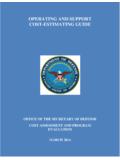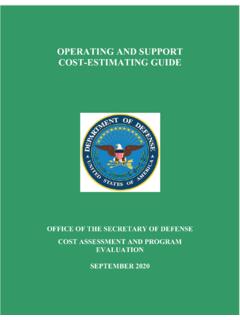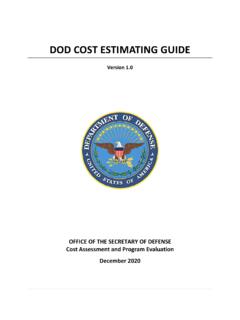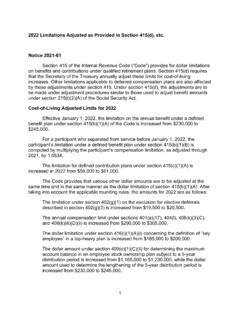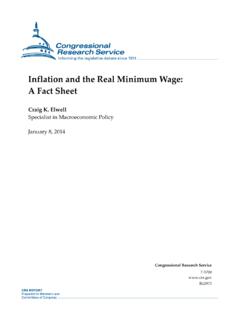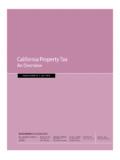Transcription of INFLATION AND ESCALATION BEST PRACTICES FOR COST …
1 INFLATION AND ESCALATION BEST PRACTICES FOR COST ANALYSIS OFFICE OF THE SECRETARY OF DEFENSE COST ASSESSMENT AND PROGRAM EVALUATION APRIL 2016 1. Background Reliable cost analysis is critical to defense management. The rates at which the prices of defense goods are expected to change are often important determinants of system cost. Well-researched forecasts of price growth help the Department to make sound acquisition trade-offs and adequately budget for weapon Section 2334(a)(3) of Title 10, United States Code, requires the Director, Cost Assessment and Program Evaluation (DCAPE) to periodically assess and update the cost indexes used by the Department to ensure that such indexes have a sound basis and meet the Department s needs for realistic cost estimation.
2 DCAPE has published this guide to help analysts meet these objectives. Developed in collaboration with cost estimators and economists in OSD and the Military Departments, it provides best PRACTICES for incorporating price change into cost analysis. It includes: Standard terminology to distinguish between INFLATION and ESCALATION Minimum standards for documenting and labeling indices used in an analysis Use of realistic ESCALATION rates to estimate investment and sustainment costs Selection of long-term assumptions about fuel prices and other rates to maximize the realism and stability of the estimate Selection of indices for converting then year estimates to a base year Cost estimates should demonstrate understanding of price growth concepts and use accurate, relevant data.
3 Therefore, the cost community should foster the data and methods necessary to measure ESCALATION affecting weapons systems, and encourage analysts to assess all ESCALATION rates bearing on their analyses. This guide will be supplemented by an in-depth handbook to help analysts implement the best PRACTICES . 2. Standard Terminology Cost estimates should distinguish between INFLATION and changes in specific prices by adopting the following terms. An expanded glossary, including examples, appears in the Appendix. a. INFLATION refers to growth in the general, economy-wide, average price level and reflects a decrease in the value of the dollar.
4 B. A change in a specific price, or in the prices of a particular set of goods and services, is not INFLATION . INFLATION is only one component of a price change. The term ESCALATION may be used for price changes below the level of the economy as a whole. Equivalent 1 DoD Instruction , Cost Analysis Guidance and Procedures, states, It is DoD that analysis be conducted to provide accurate information and realistic estimates of cost for DoD acquisition programs. 2 terms include price ESCALATION , specific price change, specific price ESCALATION , or simply, price change.
5 Examples of ESCALATION include military and civilian pay raises, changes in contractor wrap rates, and changes in the unit cost of a particular weapon system. ESCALATION does not refer to price changes attributable solely to the mix of items being measured or significant changes in quality. ESCALATION can be positive or negative. c. Constant year (CY) dollars, also called constant dollars, have been normalized for INFLATION , not ESCALATION , using an economy-wide index such as the Gross Domestic Product Implicit Price Deflator (GDP Deflator). Constant year dollars measure what goods and services economy-wide would have cost in a base year by adjusting for the decrease in the value of the dollar.
6 This term will not be used to refer to costs normalized for specific price change. d. Real price change (RPC) is price change measured in constant year dollars. Positive real price change indicates that the item has become more expensive relative to other goods and services in the economy, while negative real price change indicates that the item has become less expensive relative to other goods and services in the economy. e. The term constant price (CP) may be used to refer to costs normalized with an ESCALATION index. A constant price indicates what a narrowly defined basket of goods would have cost in a base year.
7 Examples of constant prices include contractor labor rates divided by a labor rate index, aircraft unit costs divided by an aircraft index, and fuel costs divided by a fuel price index. Constant prices exclude both INFLATION and real price change. Table 1 provides examples of correct and incorrect usage of the terms INFLATION and ESCALATION . Table 1 Examples of Correct and Incorrect Terminology What Happened Examples of Correct Terminology Examples of Incorrect Terminology The price of medical procedures increased 3% Medical ESCALATION ESCALATION Price change Specific price change INFLATION Medical INFLATION The general price level in the increased INFLATION General price INFLATION ESCALATION Specific price change Government civilian pay increased.
8 A smaller percentage in previous years Pay raise ESCALATION Wage growth INFLATION Pay INFLATION Deescalation The unit cost index for aircraft changed as a result of major capability improvements Unit cost increase ESCALATION Price change INFLATION 3. Documentation and Labeling a. Cost estimates must document the INFLATION and ESCALATION rates used to estimate each component of the program. Documentation must be accessible to decision makers, other 3 users of the estimate, and subsequent analysts. Citations of published indices must include the chosen index, base year, source(s), and date.
9 References to analyst-developed indices must include a descriptive title, base year, source data, and date. b. Estimates expressed in a base year using an ESCALATION index, or a composite of INFLATION and ESCALATION , must be labeled constant price to distinguish them from INFLATION - adjusted estimates. The Appendix discusses options for labeling both constant year dollars and constant prices. c. Ambiguous labels, such as fiscal year dollars and base year dollars, will be annotated to indicate the index used. 4. Use of Realistic ESCALATION Rates to Estimate Then Year (TY) Dollar Costs a.
10 Cost estimates will incorporate the ESCALATION rates that best forecast funding requirements for the system being estimated, taking specific markets into account. b. Cost analysts (and the organizations publishing estimates) are responsible for determining which ESCALATION assumptions are appropriate and where they are applicable, for conducting analyses necessary to forecast ESCALATION affecting system costs, and for developing the rationale for their approach. Analysts should not rely exclusively on DoD-published indices to measure ESCALATION , as the indices for Research, Development, Testing, and Evaluation (RDT&E) and Procurement reflect INFLATION and generalized expenditure rates.
